#digitalhealth
Text
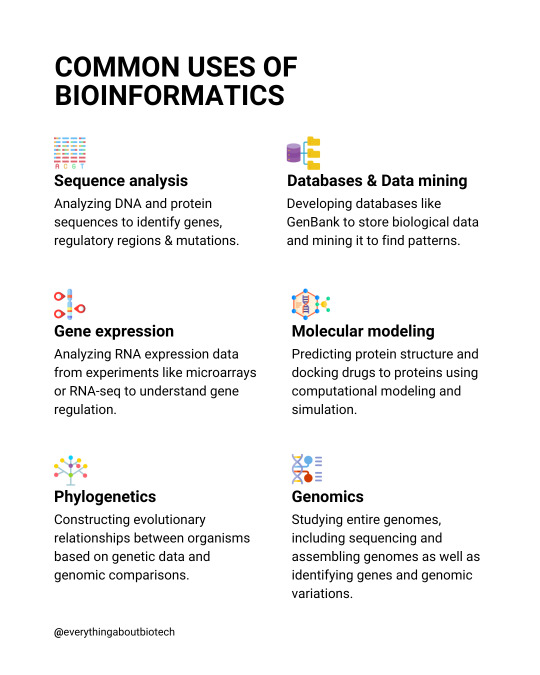
Common uses of bioinformatics
💡Sequence analysis
Analyzing DNA and protein sequences to identify genes, regulatory regions & mutations.
💡Gene expression
Analyzing RNA expression data from experiments like microarrays or RNA-seq to understand gene regulation.
💡Phylogenetics
Constructing evolutionary relationships between organisms based on genetic data and genomic comparisons.
💡Molecular modeling
Predicting protein structure and docking drugs to proteins using computational modeling and simulation.
💡Databases & Data mining
Developing databases like GenBank to store biological data and mining it to find patterns.
💡Genomics
Studying entire genomes, including sequencing and assembling genomes as well as identifying genes and genomic variations.
Follow @everythingaboutbiotech for useful posts.
#bioinformatics#genomics#proteomics#sequencing#PCR#biodata#bioIT#precisionmedicine#digitalhealth#biotech#DNA#healthtech#medtech#biostatistics#bioinformaticsjobs#BLAST#microarray#GenBank
34 notes
·
View notes
Text
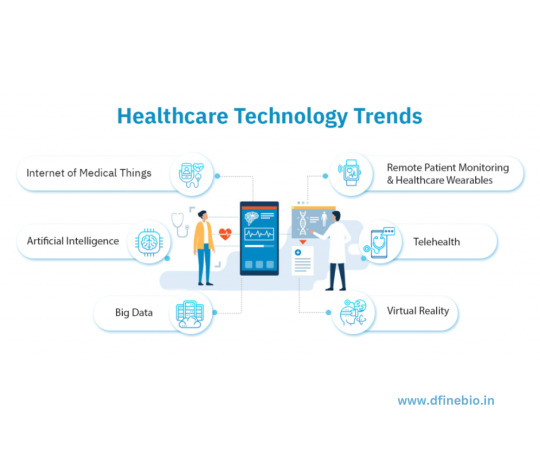
The future of healthcare with the latest tech trends! 💡 From AI-driven diagnostics to telehealth innovations, the healthcare landscape is evolving. 🚀 Stay tuned as we explore the cutting-edge technologies shaping a healthier tomorrow. 🏥
2 notes
·
View notes
Text
Analysis of: "From Brain to AI and Back" (academic lecture by Ambuj Singh)
youtube
The term "document" in the following text refers to the video's subtitles.
Here is a summary of the key discussions:
The document describes advances in using brain signal recordings (fMRI) and machine learning to reconstruct images viewed by subjects.
Challenges include sparseness of data due to difficulties and costs of collecting extensive neural recordings from many subjects.
Researchers are working to develop robust models that can generalize reconstruction capabilities to new subjects with less extensive training data.
Applications in medical diagnosis and lie detection are possibilities, but risks of misuse and overpromising on capabilities must be carefully considered.
The genre of the document is an academic lecture presenting cutting-edge neuroscience and AI research progress to an informed audience.
Technical content is clearly explained at an advanced level with representative examples and discussion of challenges.
Ethical implications around informed consent, privacy, and dual-use concerns are acknowledged without overstating current capabilities.
While more information is needed, the presentation style and framing of topics skews towards empirical science over opinion or fiction.
A wide range of stakeholders stand to be impacted, so responsible development and governance of emerging neural technologies should involve multidisciplinary input.
Advancing both basic scientific understanding and more human-like machine learning is a long-term motivation driving continued innovation in this important field.
Here is a summary of the key points from the document:
The speaker discusses advances in using brain signal recordings (fMRI) to reconstruct images that a person is viewing by training AI/machine learning models.
An example is shown where the top row is the actual image viewed and the bottom row is the image reconstructed from the person's brain signals.
Larger datasets with brain recordings from multiple subjects are allowing better models to be developed that may generalize to new subjects.
Challenges include the sparseness of brain signal data due to the difficulty and costs of collecting it from many subjects.
A model is presented that maps brain signals to a joint embedding space of images and text, allowing reconstruction of novel images from new brain signals.
Examples are shown where the reconstructed images match fairly well or not as well depending on image details and semantics.
Issues around ethics, risks of misuse, and questions of explaining and improving the models are discussed.
Ongoing work aims to address challenges around transferring models between subjects and measuring reconstruction performance.
Based on the content and style of the document, it appears to be an academic lecture or presentation.
Key evidence points include:
The document consists primarily of a speaker talking and presenting slides/examples to an audience, as indicated by phrases like "Let me just start with this" and an applause at the end.
Technical topics from neuroscience and machine learning/AI are discussed in detail, such as fMRI brain recordings, reconstructing images from brain signals, modeling approaches, dataset descriptions, and challenges/questions in the field.
Academic concepts like human subjects studies, building models, transferring learning, and measuring performance are referred to.
The presentation of information is intended to educate the audience on the state of the field and cuttting edge research, not just entertain.
There are no narratives, characters or creative storytelling elements - it adheres strictly to explaining complex technical content.
Therefore, based on the instructive/educational style and focus on explaining advanced technical research, I would classify the genre of this document as an academic lecture/presentation intended to inform an audience about progress in the domain of neuroscience and artificial intelligence.
Here are some of the key stakeholders that could be affected by the content and topics discussed in this document:
Neuroscience researchers - Directly interested and impacted by advances reported from their field of study. Progress informs future research directions.
AI/machine learning researchers - Models and challenges discussed could inspire new research at the intersection of AI and neuroscience. Transfer of model techniques.
Medical/clinical communities - Potential applications to diagnosis, personalized medicine if models can accurately reconstruct brain states. Raises ethical issues.
Government research agencies - Fund future related research based on understanding of opportunities and challenges conveyed. Evaluates societal impacts.
General public - Increased understanding of science helps engagement but topics like brain reading raise public concerns around privacy, consent if translated beyond research.
Research participants - Summary does not disclose identities but motivates others to contribute data for progress. Well-being depends on responsible use of data.
Technology companies - Commercial opportunities from real-world applications but also reputational risks if misused. Data ownership questions.
Academic institutions - Collaborations, education of next generations of researchers on cutting-edge topics is enabled through open dissemination of knowledge.
Overall the document provides value to a wide range of stakeholders by communicating the state and potential implications of this multidisciplinary area of neuroscience and AI research. Responsible stewardship is important given several ethical considerations.
Here is a summary of the key points about advances in using brain signal recordings from the document:
Researchers are using fMRI to record brain signals as people view images, in order to reconstruct the viewed images from the brain activity patterns alone.
Machine learning models, especially neural networks, are allowing researchers to train mappings from brain signals to representations of semantic content like images and text.
Examples show the capability of reconstructing fairly accurate images that a person viewed, based solely on their brain activity recordings during viewing.
Larger datasets with multiple subjects are important to develop models that may generalize beyond individual subjects. However, fMRI data is very difficult and expensive to collect at scale.
Advances now allow reconstruction of more complex stimuli like full stories a person reads, not just static images.
Ongoing work aims to better understand brain learning processes and apply those principles to more human-like machine learning architectures.
Analyzing brain recordings also has potential applications for medical diagnosis, lie detection, personalized medicine as models improve.
Ethics must be carefully considered to ensure technologies for reading neural signals are developed and applied responsibly and avoid misuse or privacy violations.
So in summary, the document outlines significant progress using machine learning on brain recordings to reconstruct sensory experiences, with applications and open questions that can further both neuroscience and AI.
Here is a summary of the key points about the sparseness of brain signal data:
Collecting fMRI brain signal recordings from large numbers of subjects is extremely challenging and costly due to the resources and time required.
Each recording session with a single subject takes considerable time, as the number of images/stimuli that can be presented is limited within a session.
Collecting data from a single subject sufficient for training complex models may require recording sessions over multiple days or weeks.
As a result, publicly available datasets typically contain recordings from only a small number of subjects, often under 10.
The sparseness of data makes it difficult to develop robust models that will generalize well to new subjects that lack extensive recordings.
Researchers aim to better leverage smaller datasets by training models that can reconstruct novel stimuli from just a subset of training data per subject.
If successful, this could enable more efficient data collection, such as obtaining usable models from a subject after a single shorter session rather than many long sessions.
However, overcoming the sparseness of brain signal data remains a major challenge holding back progress in the field. Larger collaborative datasets are needed.
So in summary, sparse data severely limits progress but also motivates techniques to optimize learning from limited samples per subject.
Here is a summary of key points regarding risks of misuse from the document:
Advances in reconstructing cognitive states like images viewed from brain recordings raise potential dual-use concerns if technologies are not regulated.
Applications in medical diagnosis and lie detection could help many, but lead to issues if used without consent or for non-medical surveillance.
Overly ambitious claims about capabilities need to be avoided to prevent misleading expectations that could fuel inappropriate usage assumptions.
Privacy and security of sensitive neural data must be prioritized to prevent potential misuse for profiling, identification or manipulation without oversight.
Commercial pressures may incentivize premature deployment before understanding implications, so continued research is important.
Public education about limitations and complexities involved can help curb fears that fuel misuse if capabilities are overestimated.
Multidisciplinary cooperation ensures societal and ethical issues are considered proactively rather than reactively addressed later.
Governance frameworks may be needed to steer applications toward public benefit rather individual or state abuse of personal mental information.
The speaker acknowledges misuse risks to inform discussion and underscore the importance of ongoing examination of new neural technologies through multidisciplinary lens including ethics.
Based on the content and style of presentation, my evaluation of the document status is:
Science vs Fiction: Clearly grounded in science as it discusses ongoing empirical research studies using neuroimaging and machine learning techniques. No fictional or hypothetical elements.
Empirical vs Anecdotal: Empirical in nature, rooted in dataset collection from human subjects and quantitative modeling/evaluation, not personal experience. While data quantities are limited, research follows scientific method.
Fact vs Opinion: Primarily presents technical details and research findings as established facts from the literature. Does not advance strong personal opinions beyond realistic discussion of challenges. Maintains an objective tone.
Objective vs Subjective: Remains objective in explaining research accomplishments and questions objectively without emotive language or bias. Any subjective experience like dataset limitations are clearly labeled as such. Presentation aims for factual information transfer.
In summary, while farther research is still ongoing, the document presents the current state of a scientific research domain factually based on empirical evidence and quantitative analysis published in the field. It does not intermingle non-factual elements or stray from an objective reporting of the topic at hand. The status therefore skews heavily toward science, empiricism, fact and objectivity.
I did not identify any logical fallacies in the content or arguments presented in this document.
The speaker objectively summarizes established research results and proposals, without making assertions that require logical scrutiny.
Some key reasons why logical fallacies are not present include:
No causal claims are made without proper evidence or empirical support from published studies. Progress is tied to concrete research efforts.
No arguments are constructed through flawed reasoning or non sequiturs. Concepts are explained clearly and build upon each other logically.
Comparisons to other approaches are fair without strawman misrepresentations of opposing ideas. Related work is acknowledged.
Limitations and open challenges are candidly outlined rather than ignored or obscured through fallacious defense.
No emotional, exaggerated or politically motivated language is used that could constitute emotional appeals. Tone remains factual.
No false dilemmas or false attributions of complexity are presented. Discussions appropriately scope multi-factor research questions.
No hasty generalizations are made from limited evidence. Data constraints are clearly communicated.
Overall, through objectively summarizing established neuroscience and AI research domains and techniques, without engaging in argument or debate, I did not find any logical fallacies employed in this academic information-sharing document. The focus appears to be factual reporting of progress and issues, avoiding fallacious reasoning.
Here is an evaluation of the ethics addressed and considered in the document:
Informed consent is implied but not explicitly discussed for research participants. Given the sensitivity of brain data, proper protocols were likely followed.
Privacy and anonymity of participants is a concern, but cannot be fully assessed without more details on the dataset and review process.
Potential dual-use issues around brain reading/reconstruction technologies are identifed by discussing applications but also worries about misuse or lack of oversight. This shows awareness of ethical implications.
Limitations and challenges and openly discussed, avoiding overpromising on capabilities. This establishes credibility and sets appropriate expectations.
Societal impacts and usage beyond research (e.g. diagnostics) are flagged as requiring careful consideration of risks like surveillance, discrimination if not regulated properly.
No claims are made without empirical evidence, showing results are driven by facts rather than desires which can bias judgment. Objectivity helps ethical analysis.
Multidisciplinary collaboration is emphasized , suggesting diverse viewpoints were incorporated into the research process.
Overall, while full review details are not provided, the document demonstrates an awareness of important ethical considerations around privacy, consent and responsible development for these sensitive types of neural data and technologies. A balanced assessment of opportunities and risks is conveyed.
Here are the usual evaluation criteria for an academic lecture/presentation genre and my evaluation of this document based on each criteria:
Clarity of explanation: The concepts and technical details are explained clearly without jargon. Examples enhance understanding. Overall the content is presented in a clear, logical manner.
Depth of technical knowledge: The speaker demonstrates thorough expertise and up-to-date knowledge of the neuroscience and AI topics discussed, including datasets, modeling approaches, challenges and future directions.
Organization of information: The presentation flows in a logical sequence, with intro/overview, detailed examples, related work, challenges/future work. Concepts build upon each other well.
Engagement of audience: While an oral delivery is missing, the document seeks to engage the audience through rhetorical questions, previews/reviews of upcoming points. Visuals would enhance engagement if available.
Persuasiveness of argument: A compelling case is made for the value and progress of this important multidisciplinary research area. Challenges are realistically discussed alongside accomplishments.
Timeliness and relevance: This is a cutting-edge topic at the forefront of neuroscience and AI. Advances have clear implications for the fields and wider society.
Overall, based on the evaluation criteria for an academic lecture, this document demonstrates strong technical expertise, clear explanations, logical organization and timely relevance to communicate progress in the domain effectively to an informed audience. Some engagement could be further enhanced with accompanying visual/oral presentation.
mjsMlb20fS2YW1b9lqnN
#Neuroscience#Brainimaging#Neurotechnology#FMRI#Neuroethics#BrainComputerInterfaces#AIethics#MachineLearning#NeuralNetworks#DeepLearning#DataPrivacy#InformationSecurity#DigitalHealth#MentalHealth#Diagnostics#PersonalizedMedicine#DualUseTech#ResearchEthics#ScienceCommunication#Interdisciplinary#Policymaking#Regulation#ResponsibleInnovation#Healthcare#Education#InformedConsent#Youtube
2 notes
·
View notes
Text
2 notes
·
View notes
Text
Explore your choice...
The statement “Health is Wealth” is a Nice and Wonderful statement that illustrates the value of health benefits of human body. Every human body consists of so many nerves, muscles, bones and organs associated with continuous flow of blood…
If a person had healthy body, then he/she will enjoy pleasures and joy in every aspect of life. A healthy body will give physical pleasures and internal joy that will lead to a peaceful mind and joyful soul…
Read more...
#Healthcare#HealthTech#HealthcareTechnology#MedicalInnovation#DigitalHealth#HealthcareIndustry#HealthcareSolutions#HealthcareIT#HealthcareServices#HealthcareManagement#HealthcareProviders#HealthcareSystems#HealthcareLeadership#MPMTechnologies#MPMTech#HealthcareSoftware#MedicalDevices#HealthcareAnalytics#HealthcareAutomation#Telehealth#medicare#telehealth
2 notes
·
View notes
Link
Mobile apps are transforming the #healthcare industry, from improving #patientcare to streamlining medical processes.
Stay ahead of the game and learn more about the impact of mobile apps on healthcare
2 notes
·
View notes
Link
What is #healthcare 🩺 #AI 🤖🧠?
#HealthcareAI is the application of #ArtificialIntelligence to #MedicalServices and the #administration or delivery of medical services. #MachineLearning (#ML), large and often unstructured #datasets, advanced #sensors, #NaturalLanguageProcessing (#NLP) and #robotics are all being used in a growing number of healthcare sectors.
___💥___The 10 areas of AI applied to Healthcare:
1. Healthcare administration 🧑💼
2. Public health 🏛️
3. Medical research 🔬
4. Medical training 👩🏫
5. Medical professional support 🧑⚕️
6. Patient engagement 😷
7. Remote medicine 💻
8. Diagnostics 🧪
9. Surgery 🥼
10. Hospital care 🏥
#digital#healthcare#digitalhealth#pharmaindustry#digitaltransformation#medicaldeviceindustry#lifescienceindustry#healthcaremanagement#ehealth#digitalhealthcare#commercialexcellencebulletin
2 notes
·
View notes
Text
Healthcare Mobile Apps Development - Mindnotix

Easily connect with patient through healthcare mobile apps
#healthapp#healthcare#health#healthylifestyle#doctor#digitalhealth#fitnessapp#app#iosapp#covid#doctorapp#doctorsappointment#wellness#healthapps#androidapp#startup#doctorlife#startupindia#labtest#healthcareapp#healthexpert#medical#medicine#hospital#nurse#doctors#healthylifestyles#software engineering#python#linux
2 notes
·
View notes
Text
NeuroFlow - A Progressive Digital Health Company!
Know how Does NeuroFlow Digital Health Company Offer Absolute Sanity?
Read more about this: https://www.algoworks.com/blog/track-overall-wellbeing-with-neuroflow/

#neuroflow#digital#health#company#algoworks#absolutesanity#digitalhealth#sanity#digitalhealthcompany
2 notes
·
View notes
Text
Panacea Online Doctor Booking App Design Kit
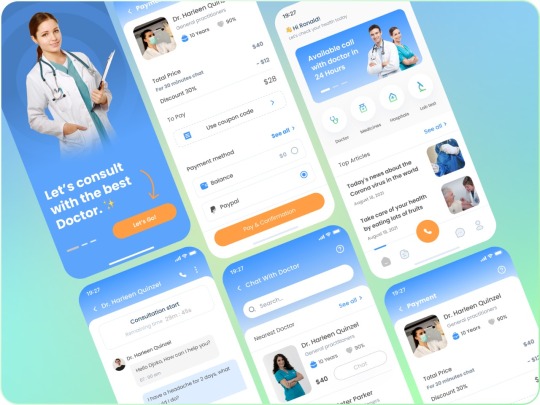
Panacea Super Medical App UI Kit 120+ Screens, Available for Figma & Sketch 🔥🤘 designed by Cynocraft 🏆 for Web and mobile.
#uxdesign#ui/ux#uidesign#uxresearch#Mobile#healthapp#healthcare#health#healthylifestyle#doctor#digitalhealth#fitnessapp#app#iosapp#covid#doctorapp
2 notes
·
View notes
Text
Rethinking the Timing of Medical Diagnosis and Treatment
Rethinking the Timing of Medical Diagnosis and Treatment
This week I am talking to John Martin, M.D., Chief Medical Officer, Butterfly Network, Inc. (@ButterflyNetInc) who is revolutionizing the traditional practice of medicine by adding imaging capabilities to the doctor’s tool bag earlier in the diagnosis and treatment process of patients.
John’s career started in vascular surgery where he found his ability to bring about positive change to patients’…

View On WordPress
#AI#butterfly#Cancer#Communication#Digital Health#DigitalHealth#Disruptive#education#Healthcare#Healthcare Technology#image#imaging#Incremental#Incremental Healthcare#IncrementalHealth#iPhone#Machine Learning#Medical Devices#Medical Education#Medical School#Medicine#patients#physical examination#physician#question#skill#Technology#TheIncrementalist#ultrasound
4 notes
·
View notes
Text

"Transformative Learning, Unforgettable Experiences: Dive into Our Workshop Journey! “the workshop with Probulin Probiotics' Dr. Jason Mitchell. We are pleased to invite you to the free workshop on May 21, 2024, at Grand Hyatt Dubai Riyadh Street, United Arab Emirates.
Workshop Title: The Evolution in Probiotic Therapy
For workshop details, visit here: https://gastroenterology.universeconferences.com/the-evolution-in-probiotic-therapy/
#ProbulinProbiotics#InternalMedicine#GP#healthcare#Doctors#healthcareconference#Hospitals#medical#health#Primaryhealth#mentalhealth#digitalhealth
0 notes
Text

Call For Paper
Submit your paper with many more benefits at our upcoming 14th World Healthcare, Hospital Management, Nursing, and Patient Safety Conference from July 25-27, 2024 in Holiday In Dubai, UAE & Virtual!
This is your chance to share your insights, expertise, and vision with a diverse audience eager to learn and engage.
Submit here: https://nursing.universeconferences.com/submit-abstract/
Abstract Submission Deadline: April 30th, 2024
#PandemicResponse#Qualityimprovement#Telenursing#VirtualNurse#Telemedicine#DigitalHealth#NursingTech#Telecare#Telemonitoring#Teleconsultation#HealthTech#Teletriage#TelemedicineNurse#eHealth#RemoteNursing#TelehealthNurse#Healthcaresummit
0 notes
Text


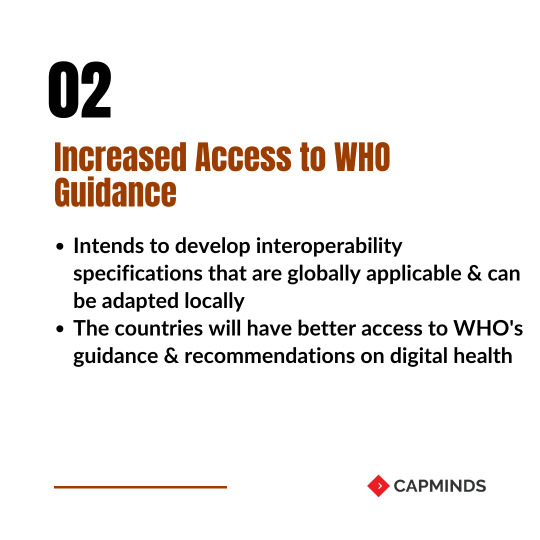

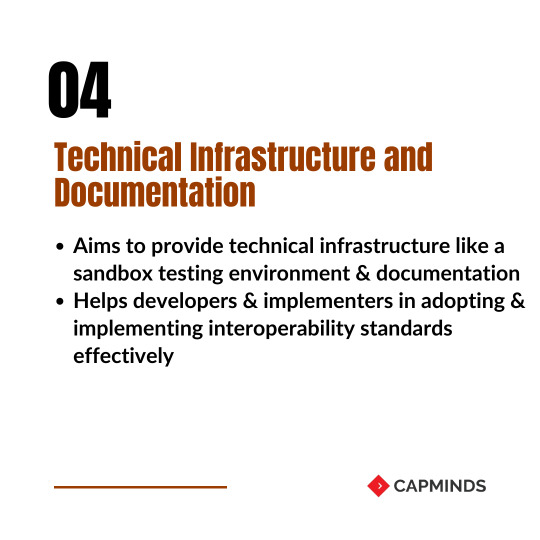
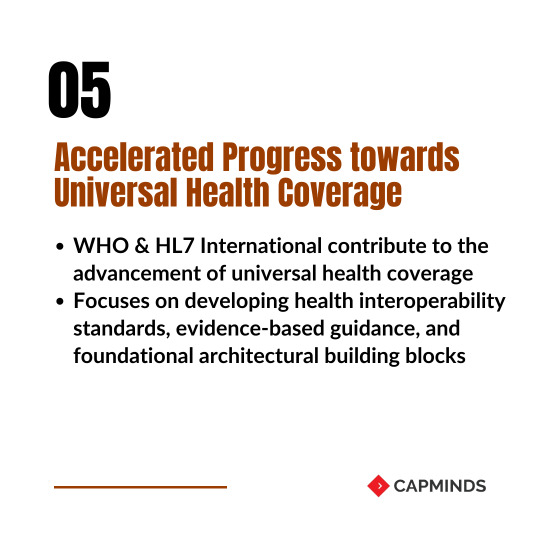
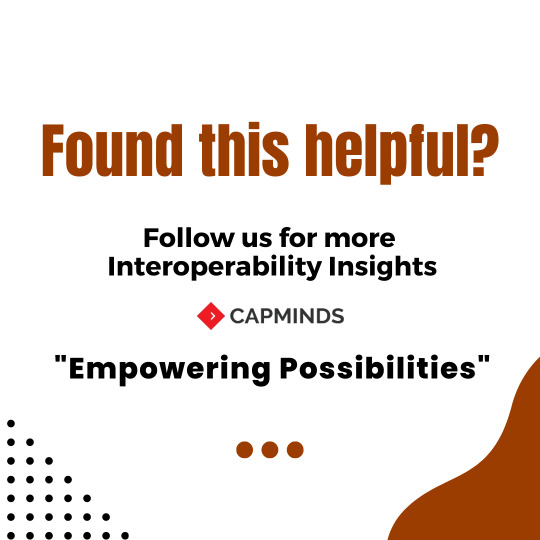
The collaboration between WHO and HL7 International brings together their respective expertise and resources to drive the adoption and appropriate use of interoperability standards globally.
This collaboration has the potential to harmonize digital health systems, improve data exchange and continuity of care, and contribute to the overall goal of achieving universal health coverage.
2 notes
·
View notes
Text

Experience the future of healthcare with Telehealth and AI: Enhancing Remote Care Delivery! Explore how artificial intelligence is revolutionizing telemedicine, enabling personalized and efficient remote care. Discover how AI-powered algorithms streamline patient triage, diagnostics, and treatment planning, ensuring high-quality healthcare from anywhere. Join us in reshaping the landscape of telehealth, where technology and compassion converge to empower accessible and effective healthcare for all.
0 notes
Text
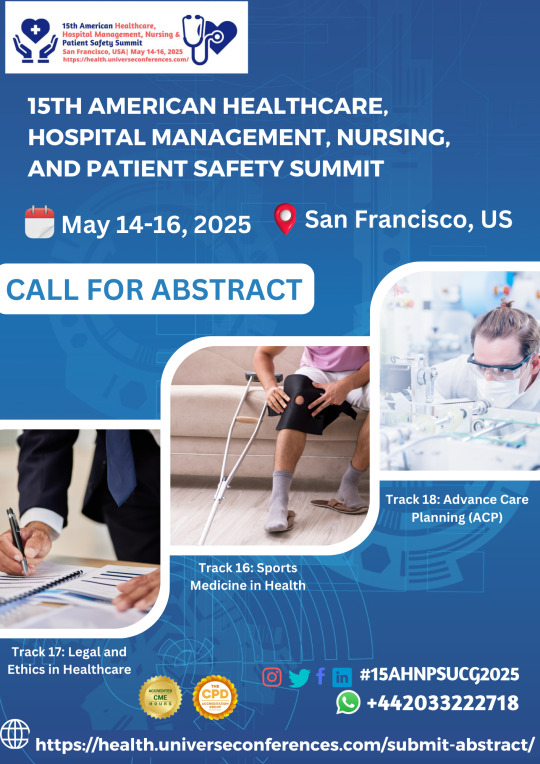
Call for Abstract
Crafting ideas into innovation, one abstract at a time at the CME/CPD accredited 15th American Healthcare, Hospital Management, Nursing, and Patient Safety Summit from May 14-16, 2025 in San Francisco, USA.
WhatsApp us at https://wa.me/442033222718?text=
submit your paper/abstract here: https://health.universeconferences.com/submit-abstract/
#Primaryhealth #Healthsummit #Healthcaresociety #HealthWellness #HealthierYou #RetailClinic #DigitalHealth #Telemedicine #PharmacyServices #healthcare #Doctors #Primaryhealthcare #Hospitals Show less
#Primaryhealth#Healthsummit#Healthcaresociety#HealthWellness#HealthierYou#RetailClinic#DigitalHealth#Telemedicine#PharmacyServices#healthcare#Doctors#Primaryhealthcare#Hospitals Show less
0 notes